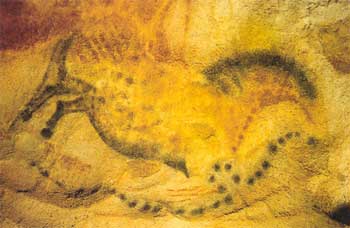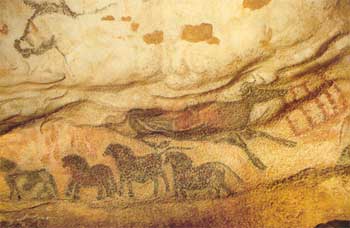


|
4. LASCAUX II - good fake prehistoric paintings
Perigord Region
On September 12, 1940 four teenage boys discovered a cave near Lascaux that had paintings of animals, hunts, and wars on its ceiling and walls. Within 10 years the display of these paintings was attracting crowds of 1500 visitors daily.
The paintings are very fragile, and their long endurance required the natural climate of the cave. The visitors raised the temperature, changed the level of humidity, brought dust, seeds and pollen into the cave. The light of the lamps bleached the paintings and made the growth of plants possible. White and green diseases threatened the stability of the images. Consequently the cave was closed to tourists in 1962.
To allow visitors to see the cave paintings, an exact facsimile called Lascaux II (faux Lascaux), was built just 200 metres from the original cave. In Lascaux II two galleries have been reproduced: the Bulls Room and the central corridor. These two areas of the cave show the majority of the paintings at Lascaux.
The construction of the replica was a challenge, for naval engineers to recreate exactly the organic form and generate a map, and for scientists and artists, to demonstrate how the paintings were made. Inside a shell of reinforced concrete, with the contours of the cave on the inside, the paintings were executed in the same manner and using the same types of materials used 17,000 years ago. Natural pigments like ochre, charcoal, and iron oxides.
In cave iconography the third dimension is effectively suggested at several levels. Lines and forms overlap and depart one another in sophisticated ways. A three dimensional effect is achieved both in the overall portrayal of the subject and in the slightest anatomical details. A line that marks a topographic change in the cave wall might also simultaneously be the line of a hip of a bull( very effective under a dynamic light like a torch). Figures are placed in a manner to create a group perspective.
The simulation recreated the degradation of the original, so some figurative or schematic elements are difficult to perceive. There are many reasons for this: the figure has deteriorated, several entities have been superimposed, it has been obscured either by a more recent drawing, by a calcite deposit or by clay having run down over it...
D was full of enthusiasm and envious, K found it wondrous, and M and W went to find something to buy at the souvenir window.
|